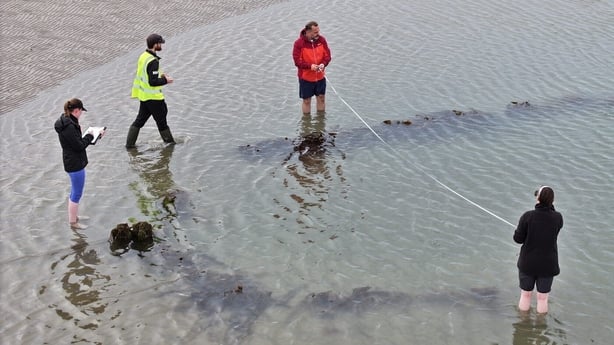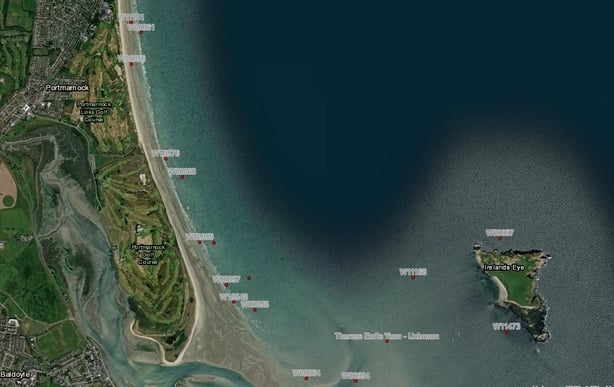Work is under way to identify the origins of three historic shipwrecks that were discovered on Portmarnock Strand in Dublin over the summer.
The wrecks were exposed due to a shifting sandbank, which also exposed another wreck, which has not been visible for seven years.
The National Monuments Service (NMS), which is responsible for recording shipwrecks around Ireland, said the number of wrecks off the coast of Portmarnock is “unusually high”.
The discoveries were made after a local underwater photographer and drone operator Nigel Motyer was recording footage on the beach in late July and noticed the shape of a ship protruding from the sand.
He alerted the National Monuments Service, which keeps a register of shipwrecks off the Irish coast, and its staff inspected the area.
They determined that the wreck Mr Motyer had captured images of had been previously recorded in the Wreck Inventory of Ireland. It was last visible in 2017 and prior to that in the 1990s.
However, during the investigation, carried out by underwater specialists from the NMS, they discovered three new shipwrecks that had not been previously documented.
The NMS team surveyed and photographed the wrecks and are now carrying out analysis of the materials, size and construction style of the shipwrecks to help identify the vessels.
Some 50 wrecks are recorded in the Wreck Inventory around the Portmarnock and Baldoyle areas.
The physical remains of at least 13 of these vessels have been located.
The documented wrecks range from 14th century trading ships to 20th century coal-boats and research suggested that most of the vessels recorded off Portmarnock Strand were lost during bad weather.
Several of the ships en-route to Dublin may have attempted to seek refuge in Howth Harbour during stormy conditions but failed to reach the safety of the harbour entrance and were compelled to run ashore on the strand to save lives.
Other ships, originating from ports on the west coast of Britain and bound for various global destinations, seem to have been driven ashore by stormy weather.

The NMS said the new wrecks appear to be stable and will most likely cover over again in the coming weeks and months which will help safeguard them from further deterioration and degradation.
Senior Archaeologist at the National Monuments Service Karl Brady described the discovery as exciting and said their initial detective work leads them to believe they may be able to identify the origins of two of the three new vessels.
“It was really amazing because I’ve been walking this beach for 25 years recording wrecks and I’ve never seen this many wrecks uncovered. So it was really exciting.
“We look at specialist maritime sources such as newspapers, Lloyd’s Register and then we try and match up and align the records with what we see in the shore. This can be a difficult and challenging task because very often, not very much remains of the ship itself, and we have to carry out a lot of detective work to try and match it to the historic records to confirm the identity of the wreck.
Mr Brady said shipwreck records revealed a “good match” of a wreck called the Malfilatre which went ashore very close to a specific point on Portmarnock Strand.

“It was travelling from Cardiff to Dublin at Christmas time in 1899 and encountered a ferocious storm. We know that the ship lost control and was driven ashore at this point here. The crew were forced to climb the rigging to try and prevent themselves from being washed overboard by the huge monstrous waves. And it wasn’t until the next morning that they were out to be rescued by the local Coast Guard.”
He said the other wreck is thought to be a vessel called the Gainsborough.
“It’s well known in these areas as there is a monument in Malahide, a memorial to the crew that were lost on this vessel. It was travelling from Liverpool with a valuable cargo worth over £11,000 at a time, so that would be many multiples of that in today’s money.
“Again, this vessel was washed ashore during the storm. Unfortunately, it was at night time and the crew couldn’t get ashore so they too had to latch themselves to the rigging to prevent them getting washed ashore.
“The local lifeboat crews here made valiant attempts to rescue the crew but every time they went out in their row boats, the lifeboat filled with water. Eventually they reached the vessel and rescued four of the crew but unfortunately three of the sailors were lost during that event.”

All wrecks over 100 years old are automatically protected under the National Monuments Acts.
Some 18,000 wrecks from the coast and inland waterways of Ireland are currently recorded on the NMS’s Wreck Inventory, with an average of 50 new wrecks added to it each year.
The NMS said it regularly receives reports of potential maritime discoveries, including ship timbers, mostly during winter and spring months when there is frequent storm activity.
It says any sightings of wrecks should be reported to it and that people should not tamper with or remove any parts of the wrecks.
Minister for Heritage Darragh O’Brien said the discoveries show the value of the work done by the NMS.
“There are thousands upon thousands of wrecks recorded. People wouldn’t be aware of it, but it gives you a real, clear window into our past, how people lived, how they traded.
“The interest in this locally and nationally and internationally in finds like this incredible and we wouldn’t be able to do that without the National Monuments Service. Thankfully over the last four years we’ve been able to heavily resource this area, where we have doubled the funding in the heritage area.”
We need your consent to load this rte-player contentWe use rte-player to manage extra content that can set cookies on your device and collect data about your activity. Please review their details and accept them to load the content.Manage Preferences
The Wreck Inventory of Ireland can be viewed on the NMS Wreck Viewer here: NMS Wreck Viewer
Any sightings of wrecks or exposure of archaeological objects should be reported to the National Monuments Service: nationalmonuments@housing.gov.ie
Any artefacts should be reported to the National Museum of Ireland: antiquitiesdo@museum.ie
